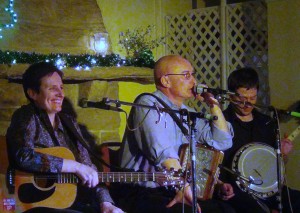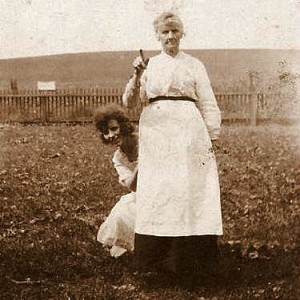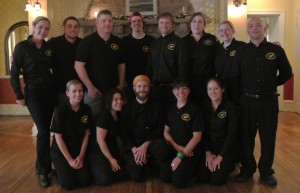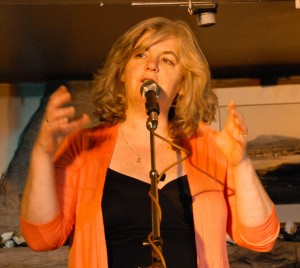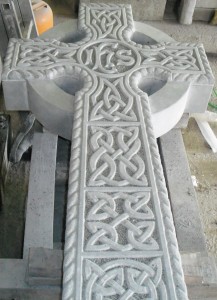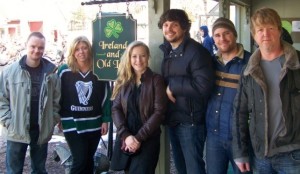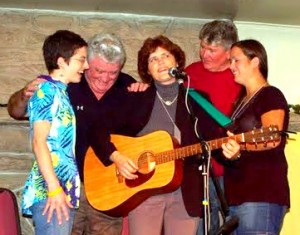Every once in a while, a live musical experience exceeds even the highest expectations and leaves its audience in a state of permanent thrall…when you walk out still mouthing the word “Wow.” The performance by Mary Courtney & Morning Star did just that when they played for the Philadelphia Ceili Group at the Irish Center in Mt. Airy on March 9th.
All three—singer and guitar player Mary Courtney, button accordionist John Redmond and tenor banjo player Donie Ryan—are well-known and highly regarded musicians in their home base of New York, but it’s long past time that they became household names to music lovers everywhere.
Though they’re residents of the Bronx these days, their Irish roots are strong and proudly displayed, with Mary hailing from Castlegregory in County Kerry, John from Ballindaggin (it means “townland of the stronghold”) in County Wexford and Donie from Lorrha, County Tipperary. Together they’re a force of talent, accomplishment and musical knowledge that is showcased by the tunes they play, and illuminated by the heavenly voice of Mary Courtney when she sings.
The group Morning Star was originally formed in 1982, by Mary, Margie Mulvihill and Carmel Johnston (who was Carmel Glendon then). Other than a hiatus of a few years in the mid 80’s, the band has been together in one formation or another ever since: “This line-up, we’ve been solid now for 6 years, 7 years,” Mary explained. “And we all freelance as well.”
Among Mary’s own freelance gigs was her time with the group Black 47, the highly regarded Celtic rock band who paved the way for today’s groups like Dropkick Murphys and Flogging Molly. She sings on their albums “Fire of Freedom” and “New York Town,” and keeps in contact with founding member Larry Kirwan. “I’m still in touch with him. We did the Sandy Seisiun benefit in the Bronx last month to raise money for the aftermath of Hurricane Sandy.”
Performing for charity events is part and parcel for the band. Immediately after their Philadelphia performance, the group was heading to Pittsburgh to play for “Row On for Brendan” at Central Catholic High School, an annual event that honors the memory of Brendan Foley, a student who passed away in 1996 at age 15. Bruce Foley, Brendan’s father, is an Irish musician, and over the years the fundraiser has raised almost $300,000 for the school’s rowing team.
The long ride ahead of them didn’t daunt Mary, and the comfort and graciousness displayed by the band onstage was just as notable after the show. “It’s wonderful to get a new audience. We got such a great welcome here in Philly…such a warm, wonderful welcome,” she said, smiling. “I’m lucky. I’m very blessed to be able to play, and to have John and Donie. And to have Beth Higgins, my partner of 11 years in my life. She’s the love of my life. I’m the luckiest person alive. I was an illegal for 10 years, and in the early 90’s I won a [Bruce] Morrison visa, now I’m a citizen of the United States. I’m very blessed.”
It’s obvious to anyone who spends a minute in Mary’s company that this is the absolute truth.
The band has a new CD out, “Mary Courtney & Morning Star ~ Live From the 33rd County,” which is available at CD Baby and Amazon. For more information, check out Mary’s website.
And here’s a (brief!) list of where you can catch Mary performing in NY:
An Beal Bocht Cafe, in Riverdale, NY. Every Friday night from 6-8, a solo ballad session
Tir Na Nog, at 8th Avenue, between 33rd and 34th, Manhattan. Most Friday nights from 8-11
St. Andrews Restaurant and Bar, on W. 46th Street, between 6th an 7th. Every Saturday night from 9-1, with Patrick Madden
O’Brien’s Irish Pub, on W. 46th Street, between Avenue Of The Americas & 7th Ave. Every other Sunday from 4-7, with Patrick Madden
Doc Watson’s, on 2nd Avenue. Every other Sunday night (the same Sundays as O’Brien’s)
Finally, if you didn’t catch Morning Star when they were in Philadelphia, here are a few videos so you can see exactly what you missed out on (you won’t do it again!):

